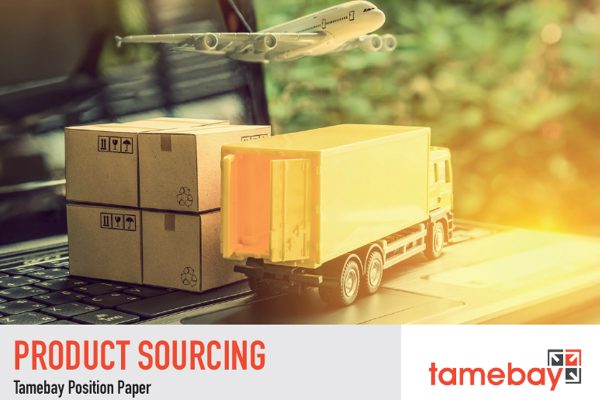Download or read online
This position paper on Product Sourcing is available as a free download to read offline at your convenience, or carry on reading below.
Product Sourcing
In the world of ecommerce, a great many businesses and merchants are generous with their time and expertise. It’s not unusual to discover people selling online, sometimes even competitors, sharing ideas and experiences with each other. It’s part of the ethos of online community that has emerged alongside internet selling. Even foes can be friendly and show great camaraderie.
But some things really are secrets. And they are guarded closely from friend and foe alike. And the most taboo subject, about which many won’t even speak, is product sourcing.
Where and how does a merchant source their stock? For obvious reasons it makes sense, often, to be protective of what is a crucial aspect of your business. It is fair to say that buying decisions for any retail business are mission critical. And it is often said that it is when buying the stock, that you make your profit. It’s not when you make a sale.
Deciding what to sell
Your merchant journey, or the type of online business you work within or seek to create, will determine how you go about sourcing stock.
An existing retailer expanding online
Opening up a new avenue for growth, by taking an existing retail business online, is a well trodden path but one that isn’t necessarily going to be a surefire success. Not only might an existing shopowner or trader lack some of the crucial technical skills required for success. It is also possible that the stock that sells well in a bricks and mortar outlet will not fare as successfully when sold online. That said, such businesses will likely already have viable suppliers and stockists so what can be a daunting problem for fledgling businesses, will be less challenging. Existing retail business, however, would be wise to consider whether they should be expanding the scope of what they sell and finding new products to sell too.
An ecommerce manager within a big retailer
If you are a professional ecommerce practitioner, the issues that surround the sourcing of stock you administer on your company’s online shop might seem quite distant. After all, other people will be responsible for the buying decisions and have expertise there. But that doesn’t mean that you don’t have a role to play. Online retail can be very different to offline and the expertise of buyers might not stretch to the peculiarities of ecommerce. That makes part of your role to provide feedback and insights to them from your everyday experience.
A new retailer, without established suppliers
Many entrepreneurs look to online selling as a way of building a business. They will consider themselves equipped with the necessary technical skills and commercial nous to give ecommerce a whirl but they don’t necessarily have set ideas in mind products they want to sell. In this instance, it’s best to analyse the market and decide, with a critical eye on the numbers, what will sell well.
Product sourcing analytics
There are numerous information sources available to merchants that will help inform your decisions and whether production/purchase prices are reasonable and potentially profitable. It is is difficult to over-emphasise the importance of data-based decision making when product sourcing.
Marketplace analytics and trends
One of the most useful tools that you can utilise will be a marketplace data mining service. These are supplied by both the marketplaces and also third parties and the information available will be dependent on the service you choose. But, at best, they provide a wealth of data related to marketplace sales, volumes, prices, competitor activity and performance over time. For instance, you should be able to tell what price a certain widget achieves on average and whether that price is appreciating or declining over time. You can then use that data to determine some of the crucial aspects of your product sourcing.
The tools can be immensely powerful so it’s well worth getting to know exactly what they can offer you and learning how to harness their power because without such information, you’ll be flying blind.
General retail trends
And outside the marketplaces, there are numerous sources of retail information that can help inform your purchasing decisions. And the data you utilise will depend on which vertical you sell into. Trade shows and buying fairs, such as Spring Fair in the UK, can be hugely useful when it comes to trend spotting and perhaps even identifying the ‘next big thing’.
There are numerous ways to source stock
The sources of products to sell on marketplaces will depend on what you have decided to sell, the nature of your business, your financial position and particualar skills. In this section we will examine the different types of suppliers and stockists.
Source stock from distributors
As you grow you’ll doubtless start looking at the more traditional supply chains such as distributors and wholesalers. You’ll likely have these in your local area. This will specifically give you the ability to have repeatable lines and have some certainty in your business by knowing you can reorder your best selling products when stocks run low. This is how most small retailers operate.
Buy from Brands and Manufacturers
The holy grail here is to strike up direct relationships with the brands and manufacturers of the products you want to sell. Although this is difficult for new business with no track record it is well worth pursuing as your long term goal. Getting a signed distribution agreement means that you can become an authorised seller of a product set and this will stand you in good stead.
Increasingly brands and manufacturers are signing up to Amazon’s Brand Registry which means that they can control which retailers are allowed to sell their products. If you are an authorised seller you know you’ll be safe if your favourite brands and manufacturers sign up.
Private label selling and building a brand
Private label selling is where you source stock directly from a manufacturer and brand it yourself for resale. This can take two forms. Firstly, you buy a consignment of generic items that have already been manufactured and add your own brand for resale.
Or you can travel the path less taken and start from scratch. This is where you design and commission brand new products for sale. This means a complex, but potentially rewarding, process whereby you work with a manufacturer to create something unique. One aspect that’s attractive about this process is building a brand, with product lines, that can be sold in its own right in the future should you wish to exit the business.
This could mean using a dedicated service like Alibaba or aliexpress.com that connects merchants directly with manufacturers in the Far East. One of the useful aspects of these services is protection. They can guarantee that you receive the goods you’ve orders, protect any funds that you send and also help you in the event of a dispute. In this scenario, one of the most critical aspects of the process lies with quality control and making sure that the manufacturers live up to their promises.
Make products to sell yourself
For the imaginative and creatively minded, crafting the goods you sell is a genuine option if you have a skill that can be transferred to production such as painting and drawing, sewing skills or a talent for metal work. Marketplaces have emerged that are specifically honed to the needs of those who want to build what they sell. Etsy is the most obvious example of such an outlet but even Amazon has muscled into the arena with their own crafts section.
‘Magpie’ sourcing
Very often in the past, online traders began their businesses by accident. It started with a clear out of a cluttered cupboard or overflowing garage and and such was the success that soon such merchants were seeking out new products to sell. And for these sellers, especially when eBay was the crucial venue and almost entirely dedicated to second-hand goods, the obvious approach was that of a magpie.
There will doubtless be those who want to take this approach today: there remains a vibrant and viable market for antiques and collectables online and obviously collectors and enthusiasts in a myriad of areas are always looking out for interesting new items.
Two words of caution should be sounded here, however. Firstly, this is a very labour intensive means of sourcing stock and requires not just your legwork as you seek out the magnificent and individual items that you will soon put up for sale. But the management of your inventory and listings will also be significantly more time consuming as you need to craft every product anew. That means written descriptions and photos that you’ll need to create for each individual item.
Secondly, even eBay is no longer exclusively, or even predominantly, focussed ‘pre-loved items” these days. Other exciting and more niche outlets are always emerging but the focus of the vast majority of marketplaces is now firmly on brand new, not used, goods.
Common mistakes merchants make when sourcing stock
As one of the most important aspects of administering an ecommerce business it’s hardly surprising that some aspects of product sourcing can be problematic or complex. And that is where mistakes can be made. As with any steep learning curve, beginners and old-hands alike will face problems from time to time, and here are some of the most common mistake made:
Over-reliance on a single supplier
Regardless of what product vertical you operate in, relying solely on a single supplier is a serious business risk. And it is vital to be cautious even if your enjoy a warm, friendly working relationship that dates back many years. There are lots of reasons why even the best and most successful of commercial relationships, such as that between merchant and supplier, can go awry.
Firstly, the supplier may itself suffer from financial problems and, in a worst case scenario, go bust. Even if they continue to prosper, they might not be able to source the goods you want at a price you like.
Secondly, changes at the supplier might mean that a key contact no longer handles your account or they are no longer willing to deal with you. That could be because of other commercial agreements they make or internal strategic changes.
Finally, it could be that your business evolves and you need more than they can supply or different products and then you won’t have somewhere to turn to source product.
That’s why, where possible, it’s vital to have good relationships with at least several suppliers to ensure that you can keep on sourcing vital stock to sell in the event of a problem. This in itself, presents a problem to merchants because some suppliers will demand exclusivity. Be prepared for commercial rivalries in the world of suppliers to be a headache.
Over-reliance on specific products
It’s exciting to find a product, or small number of products, that are performing well when you’re an ecommerce merchant.
But this brings wth it several risks that you should mitigate against. Most obviously, trends may change. The trendy red widget that has served you well for many months might simply fall from vogue and will disappear.
And then there is competition. Online marketplaces offer real openess, transparent operations, a wealth of information and intelligent practitioners. So spies are everywhere looking at what other merchants are doing successfully and looking for new ideas. If your trendy red widget is doing well, other merchants will see that and seek to emulate your success. Your challenge is to be more nimble and have your next winning line ready in the pipeline.
And, in any case, over-reliance on a narrow scope of products isn’t necessary and it pays to diversify. The skills and operations you require to sell one thing are largely identical to those required for selling anything whatsoever. Your individual tastes and interests, or the focus of your brand, may be more comfortable in a certain sector, but reduce the risk by operating across a broader sphere of products.
Purchasing too much or too little stock
It’s a fine art of prediction knowing how much stock to order from your suppliers. Once again this is where clever analytics and your own specialist commercial nous will come into play. There will always be an element of risk when it comes to estimating what level of stock will sell and how much you should buy The sometimes long lead-times make it even more challenging. But it’s vital to develop a system that works for your business. As you start out, it is probably better to be more conservative and order less until your skills are honed.
But rest assured that even experienced practitioners make a mistake from time to time and get too much stock in. And in those circumstances the vital skill is knowing when to reduce the price and start liquidating before they become loss making products.
Brexit and sourcing stock
The decision for the UK to leave the European Union, called Brexit, has brought with it particular challenges to ecommerce merchants specifically related to product sourcing. In the first instance these are related to currency markets and the fluctuation of sterling on international markets. At it’s most basic level, the result has been a diminution of the value of the pound in the period since the referendum in June 2016.
Whilst this has brought some benefits, specifically that buying products from the UK in the face of a weak pound offers good value to overseas shoppers. But it also makes sourcing product from foreign suppliers more expensive. The same goes to any merchant purchasing the raw materials from overseas to produce stock to sell in the UK.
As it stands, no end is in sight for the currency problem and we can only hope that more favourable conditions emerge and sterling makes something of a recovery. In the meantime you can mitigate some of the expense by engaging a currency exchange specialist to help lock in the best exchange rates for you.
Another concern must also be the risk of a so-called ‘Hard Brexit’. That’s where the UK leaves the EU without a deal at the end of March 2019. It is by no means certain what this will mean on a practical level but in a worst case scenario it could mean tariffs and duties on all UK imports and exports and also cause delays in shipping. Anyone who predicts with any certainty what will happen should be treated with scepticism.
Hopefully more details will become clear in the months to come and your product sourcing and ecommerce operations are largely unimpeded. We wait with baited breath for details to emerge from the negotiations. However, it is worth considering how your ecommerce operation would be impacted by tariffs, increased costs and delays should a ‘Hard Brexit’ come to pass.
Start the journey with passion
Your product sourcing journey as an ecommerce merchant of any stripe will be personal so it’s worth approaching it with some passion. That could be utilising an existing interest or area of expertise or developing a new one. But what can start with passion then needs the appliance of business acumen and sober analysis if it is to persist
But whilst the basis of your enterprise might be a personal interest, the ongoing success of any retail business is dependent on hard-nosed analytics, well-informed decisions and an approach. One of the things that makes online selling distinct from opening a shop, or even running a stall in the real world, is that you have an enormous amount if information available to you. The most successful merchants make use of that aggregated data about marketplaces, and retail trends in general, as lenses through which they can then interpret their own sales data and financials.
It’s your own expertise and information that is your secret weapon. It’s why ecommerce merchants are so protective of their product sourcing secrets. Once you’ve cracked a way of sourcing products, selling them successfully and making decent margins on each and every item, then you have cracked the online retail business. And there are plenty who want that information. Good luck with your product sourcing journey.









